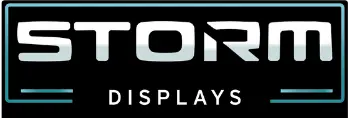Your trade show display banner is your silent salesperson. It’s the first impression—the visual handshake that convinces an attendee your booth is worth their time. In the split second it takes for them to walk by, does your banner capture their attention or just blend into the noise?
For marketing managers and exhibit coordinators, this isn't just a question of aesthetics; it's a critical strategic decision. How do you select a banner that not only represents your brand with quality but also actively helps you achieve your event goals?
This guide breaks down the essential factors for choosing a trade show banner that works. We'll explore the different types, materials, and design principles that turn a simple backdrop into a powerful tool for attracting qualified leads and starting meaningful conversations on the show floor.
Finding the Right Banner for Your Goals
Picking the right trade show banner isn’t about just grabbing the flashiest one off the shelf. It’s a strategic choice tailored to your specific goals, budget, and logistical needs. Are you a small team needing a fast setup, or are you building an immersive environment to dominate a major industry event?
Let's walk through the most common types of banners. Each has its own strengths and is built for a different kind of exhibitor.
Comparing Banner Types
When you're weighing your options, it almost always comes down to a balance between portability, visual impact, and cost.
-
Retractable Banners: These are the workhorses of the trade show circuit. Often called "road warriors," their graphics roll into a compact base for easy transport and can be set up in less than a minute. They're a lifesaver for small teams or anyone with a tight setup window and are incredibly budget-friendly.
-
Fabric Banners: If you're aiming for a premium, high-end feel, fabric is your best bet. Its matte finish eliminates glare from harsh convention center lights, making it look fantastic in photos. Fabric displays are also surprisingly lightweight. If you're curious about this style, you can explore the top fabric trade show display styles that combine elegance with fast setup.
-
Pop-Up Banners: Need to make a big impact and define your space? Pop-up banners are the classic solution for creating a large, seamless backdrop. They use a collapsible, accordion-like frame that expands to form an entire graphic wall, instantly creating an immersive environment for your booth.
-
Backlit Banners: When you absolutely have to get noticed, this is how you do it. Backlit displays use internal LED lighting to make your graphics glow from within. This makes colors pop and your message unmissable, even from across a crowded exhibit hall.
The right banner acts as a silent qualifier. A bold, backlit wall might attract high-volume traffic, while a sleek fabric banner can signal a premium, boutique brand, drawing in a more targeted audience.
To make the choice even clearer, this quick table breaks down the essentials for each banner type.
Trade Show Display Banner Comparison
| Banner Type | Best For | Portability | Visual Impact | Setup Time |
|---|---|---|---|---|
| Retractable | Frequent travelers, small budgets, quick setups | Excellent | Good | 1-2 minutes |
| Fabric | Premium branding, glare-free look, lightweight travel | Very Good | Excellent | 5-15 minutes |
| Pop-Up | Large backdrops, creating immersive booth spaces | Good | Very Good | 10-20 minutes |
| Backlit | Maximum visibility, standing out in crowded halls | Fair | Superior | 15-30 minutes |
As you can see, there’s a banner for every strategy. Your decision hinges on what matters most for your next show.
The infographic below also gives you a nice visual comparison of setup time, cost, and display area for three of the most popular options.
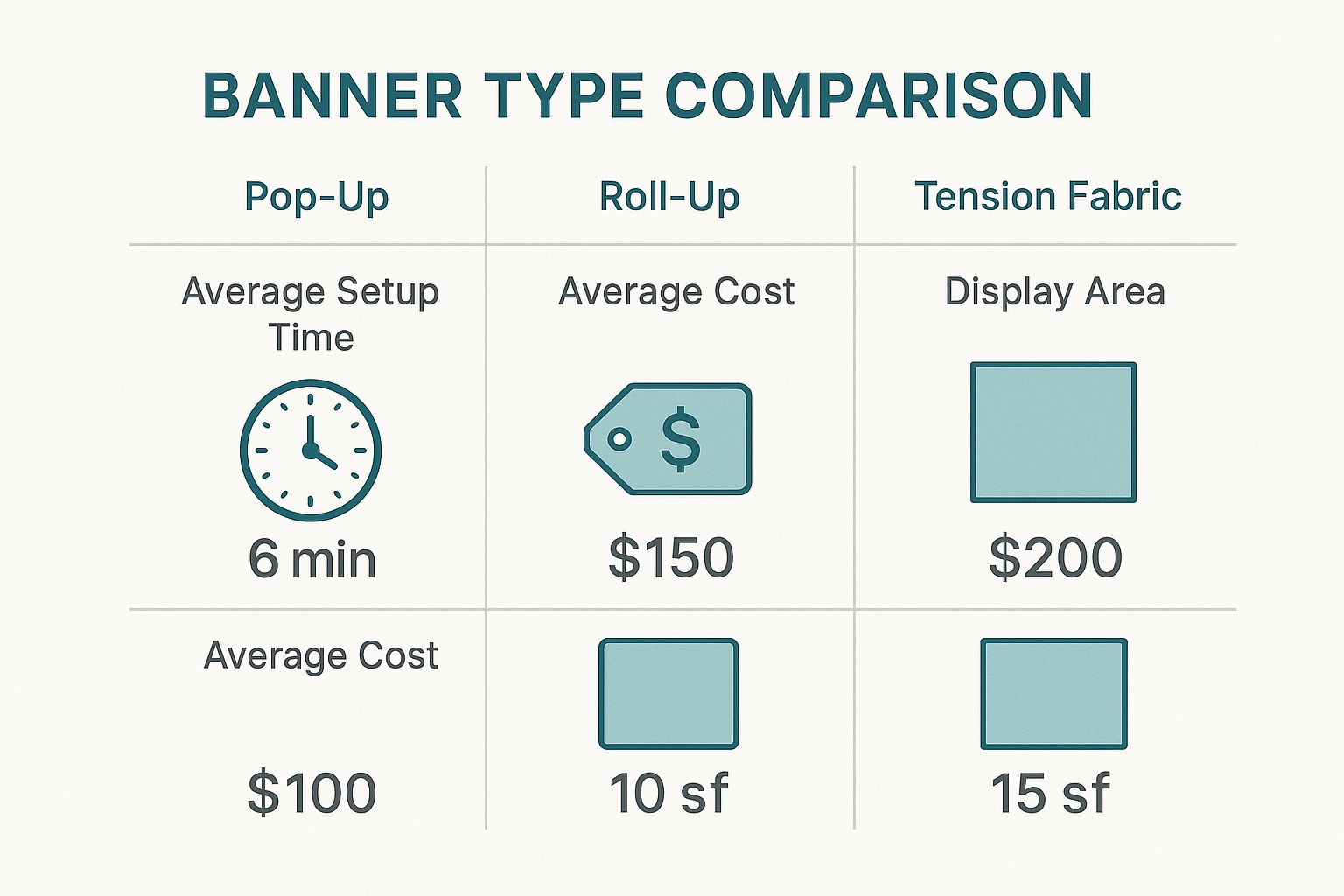
What this really shows is the trade-off you’re making. Roll-up banners give you incredible speed and affordability, but pop-up and fabric displays offer a much bigger canvas for your brand—if you have a bit more time and budget to invest. In the end, it all comes back to what's most critical for your event: speed, budget, or sheer impact.
Choosing Materials That Protect Your Brand Image
The material you choose for your trade show display banner is more than a practical decision—it’s a direct reflection of your brand's commitment to quality. A flimsy business card can undermine a great first impression; a cheap-looking banner sends a subtle message that your company might cut corners.
Picking the right material and printing process is crucial. It ensures your display not only looks sharp but can also handle the wear and tear of the demanding trade show circuit.
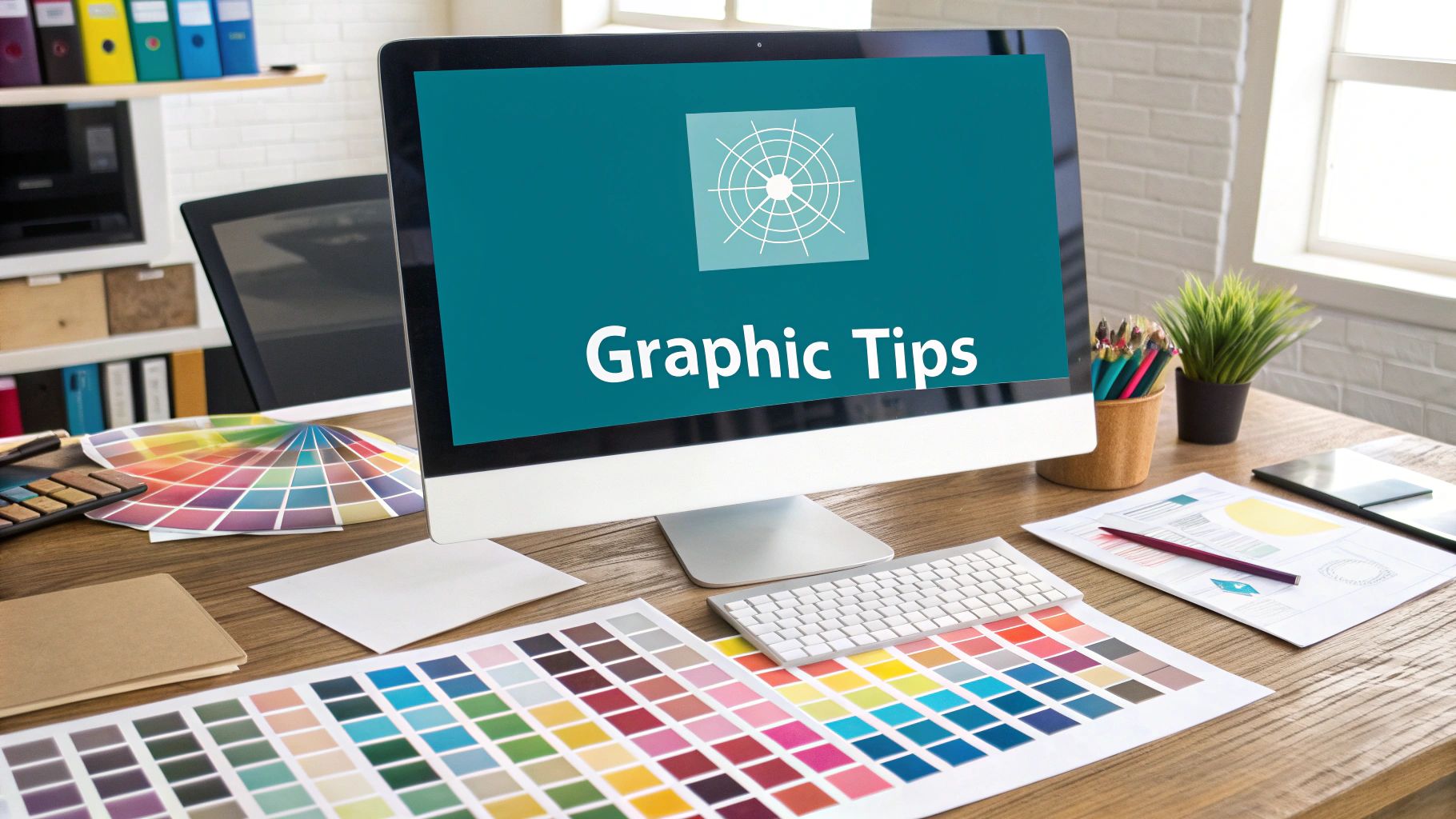
Common Banner Materials
In the world of trade show displays, you'll mainly encounter two heavy hitters: vinyl and polyester fabric. Both are solid choices, but they excel in different situations and create different brand perceptions.
-
Vinyl: The classic workhorse. Vinyl has long been the go-to for exhibitors because it's incredibly tough, weather-resistant, and budget-friendly. This makes it a fantastic, practical pick if you'll be using your banner repeatedly, especially at both indoor and outdoor events. Plus, it’s a breeze to clean.
-
Polyester Fabric: For a more premium, modern feel, fabric is the way to go. It offers a soft, high-end matte finish that eliminates the glare you often get from vinyl under harsh convention center lights. This makes fabric banners perfect for photo backdrops, ensuring your logo always looks crisp and professional on camera.
For a more detailed breakdown, check out our guide on fabric vs. vinyl to see which display type holds up better for trade shows.
Choosing between vinyl and fabric often comes down to a choice between rugged practicality and refined presentation. Let your brand identity and the event environment be your guide.
Understanding Printing Processes
The printing method is just as critical as the material itself. It's what determines the vibrancy of your colors, the durability of your graphics, and the overall impression your banner makes.
-
Dye-Sublimation (for Fabric): In this impressive process, heat is used to infuse ink directly into the fabric fibers. The ink becomes part of the material, not just a layer sitting on top. The result is a breathtakingly vibrant, continuous-tone image that won’t crack, peel, or fade. Better yet, dye-sublimated fabric is often machine washable and wrinkle-resistant—a game-changer for exhibitors who are always on the road.
-
Inkjet Printing (for Vinyl): For vinyl banners, high-resolution inkjet printers apply specialized ink onto the material's surface. Modern inkjet technology produces sharp, high-definition images with weather and UV resistance, perfect for getting crisp, clean text and detailed logos that need to be easily read from across the aisle.
By making a smart choice on materials and printing from the start, you're investing in a trade show display banner that not only looks amazing on day one but continues to represent your brand perfectly, event after event.
How to Design a Banner That Actually Stops People in Their Tracks
A great trade show display banner is more than a logo on a backdrop; it's your visual elevator pitch. On a chaotic exhibit floor, you have about three to five seconds to hook someone before they drift to the next booth. Good design is what makes those seconds count.
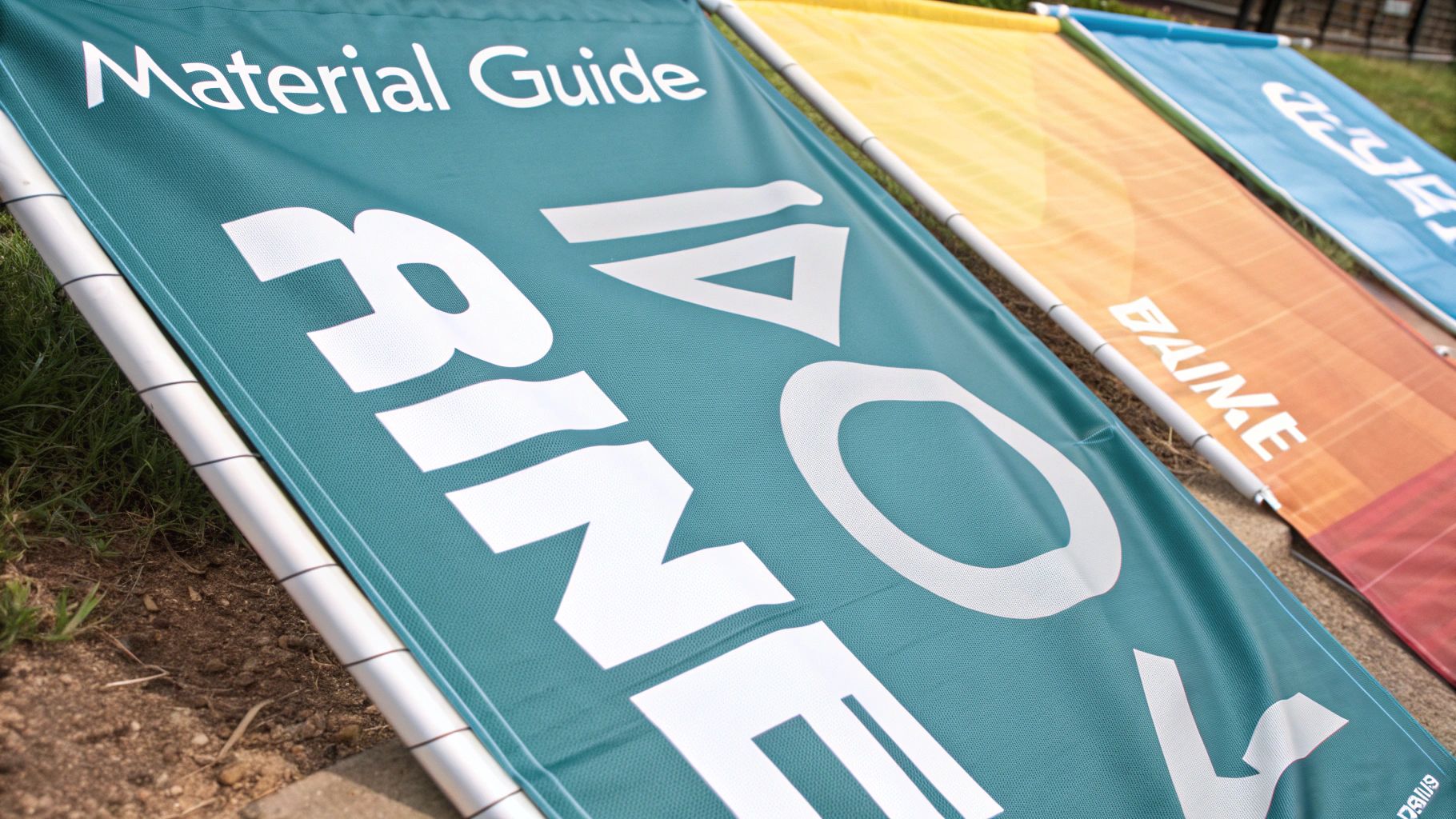
Think of your banner as the silent opener for your sales team. Its job is to nail the "5-second rule": in a single glance, an attendee should understand who you are, what you offer, and why it matters to them. If they have to squint to figure it out, you've already lost them.
Create a Clear Visual Path
The secret to instant clarity is a solid visual hierarchy. This means arranging your banner’s content so the viewer’s eye naturally follows the most important information first. A good hierarchy is simple and logical.
Place your main headline or value proposition at the top, big and bold. Supporting points or key benefits come next, followed by your logo and contact info at the bottom. This proven formula guides the viewer's eye.
Of course, a few key details can make or break the execution.
-
Crisp, High-Resolution Images: Nothing signals "amateur" like a blurry or pixelated graphic. Always use professional, high-quality images that reflect your brand's standards.
-
Smart Color Choices: Stick with your brand's color palette for consistency and recognition. Use those colors strategically to make key information pop and guide the eye.
-
Let It Breathe (Negative Space): Resist the urge to fill every square inch. A cluttered banner is overwhelming and unreadable from a distance. Negative space—the empty areas—is your friend. It makes your message stand out and feel much easier to digest.
We're also seeing some interesting design trends emerge, like biophilic design. Exhibitors are using natural textures, reclaimed wood, and even living plant walls to create a calmer, more inviting booth space that stands out from the visual noise. You can learn more about recent trade show booth trends to see how design is evolving.
Give Them Something to Do
Finally, every effective banner needs a clear and simple call to action (CTA). What's the one thing you want people to do? Don't give them a laundry list. Pick one.
Should they "Scan for a Demo"? Or maybe "Ask About Our Show Special"? Whatever it is, make it direct, concise, and impossible to miss.
Your banner isn't just a sign; it's a conversation starter. A strong CTA gives attendees a reason to step into your booth and engage with your team.
This simple addition turns a passive piece of signage into an active tool for engagement. For more ideas on how these principles scale up, check out these design ideas for high-impact display walls.
When you combine a smart visual hierarchy with high-quality graphics and a compelling CTA, your banner will do more than just look pretty. It will actively pull people out of the aisle and into a meaningful conversation.
Integrating Your Banner with Your Booth Layout
Your trade show banner can be a visual masterpiece, but if it's poorly placed or the wrong size for your booth, its impact will be lost. Think of it like a key piece of furniture in a room—it needs to fit the scale and flow of the space. A banner that’s too small will be swallowed by the visual chaos, while one that’s too big can make even a standard 10×10 booth feel cramped.
Getting the scale right is your first and most important job. The dimensions you choose should be a strategic decision that directly influences how people experience your brand's physical space.
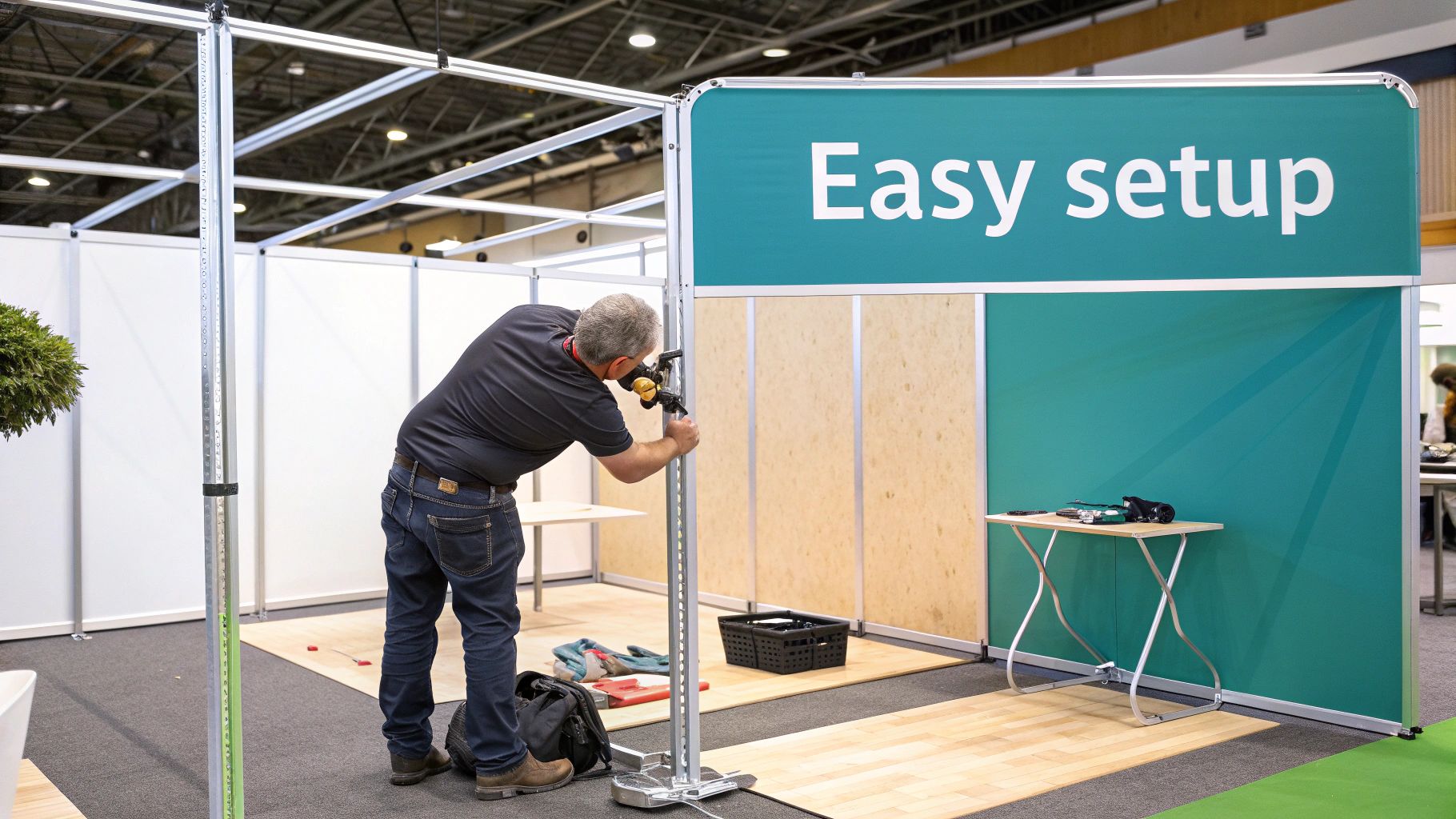
Matching Banner Size to Booth Space
For a standard 10×10 foot booth, a single large fabric backdrop is almost always the best bet. One that spans 8 to 10 feet wide instantly defines your territory on the show floor, acting as a powerful visual anchor that gives your booth a polished, professional look.
For a larger 10×20 foot booth, you have more room to play. You could go for a single, sweeping 20-foot backdrop to create a truly cinematic feel. Or, you could get creative and use two separate 10-foot banners side-by-side. This allows you to visually break up the space into different zones—perhaps one area for product demos and another for casual conversations.
Your banner shouldn't just occupy space; it should create it. Use it to guide foot traffic, frame your most important products, and build a brand environment that feels deliberate and welcoming.
Strategic Placement and Layout Ideas
With the right size secured, it all comes down to placement. The goal is to make your banner a supportive element of your exhibit, not a scene-stealer that competes for attention.
Here are a few proven layout strategies:
- The Immersive Backdrop: This is a classic for a reason. Using a large pop-up or fabric banner as your entire back wall immediately establishes a strong brand presence. It's incredibly effective when the design is clean and bold, serving as the perfect stage for your team and products.
- The Modular Approach: Several smaller, narrow retractable banners can create a dynamic, rhythmic feel. You can line them up in a row or station them at key points to highlight different features or services, offering excellent flexibility.
- The Welcome Point: Place a retractable banner at the front corner of your booth, almost like a greeter. It can carry a simple welcome message or a clear call to action, like "Scan for a Free Demo," to snag the attention of people walking the aisle.
By thinking through how your banner will function within your complete exhibit, you turn it from a simple sign into a strategic asset. A well-integrated display supports your sales team, guides attendees, and helps you achieve your event goals.
Ready to create a trade show banner that stops people in the aisles and starts conversations? The team at Storm Displays are experts in helping businesses navigate their display options. We can guide you through every step, from picking the right material to finalizing a design that gets results. Explore our custom trade show booth solutions or request a quote today to get started.
